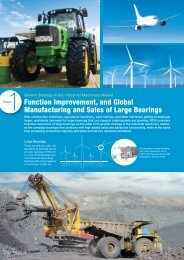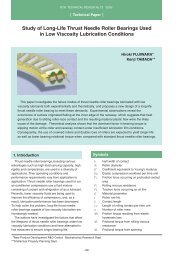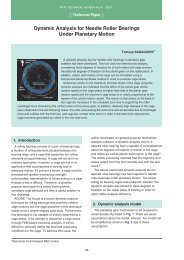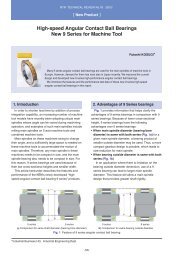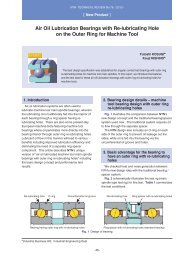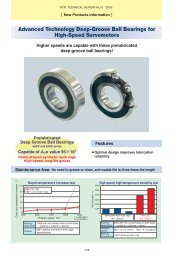Special Issue; Products for Industrial Machinery - NTN
Special Issue; Products for Industrial Machinery - NTN
Special Issue; Products for Industrial Machinery - NTN
You also want an ePaper? Increase the reach of your titles
YUMPU automatically turns print PDFs into web optimized ePapers that Google loves.
<strong>NTN</strong> TECHNICAL REVIEW No.742006<br />
Rotary table<br />
Feed-water inlet<br />
Waterway <strong>for</strong> cooling<br />
Rotary shaft<br />
Water drain outlet<br />
Workpiece<br />
Air seal<br />
Chuck surface<br />
Air seal<br />
Air thrust bearing<br />
Motor<br />
Rotary encoder<br />
Air supply opening <strong>for</strong> air seal<br />
Fig. 2 Structure of the air spindle which we developed<br />
problem, the housing on the motor and bearing<br />
sections is water-cooled and the associated<br />
components are composed of materials with low<br />
thermal-expansion in order to inhibit their thermal<br />
de<strong>for</strong>mation and the displacement of the chuck face.<br />
Furthermore, air feed holes are provided in the bore<br />
sides of the motor stators <strong>for</strong> feeding compressed air<br />
to cool the motors.<br />
For evaluation of the control measure against<br />
thermal de<strong>for</strong>mation, the aerostatic bearing spindle<br />
was started from a standstill in a room temperature<br />
environment and allowed to run constantly at 20,000<br />
r/min, and displacement in the position of the<br />
workpiece was measured. This measurement result is<br />
graphically plotted in Fig. 4. Immediately after the start<br />
of operation, the shaft developed an elongation of<br />
5. Spindle Evaluation Test<br />
A dummy workpiece simulating an actual workpiece<br />
was mounted to the prototype spindle, and then the<br />
spindle was subjected to an accuracy evaluation test.<br />
Run-outs were measured at the locations shown in<br />
Fig. 3 with a capacitance type non-contact<br />
displacement gage. Jitter (variation in rotation<br />
frequency) was determined by measuring variation in<br />
the frequency of Z-phase signal (1 pulse/revolution) of<br />
the rotary encoder with a pulse jitter counter. The<br />
measurement result <strong>for</strong> non-repetitive run-out (NRRO)<br />
is summarized in Table 2 and that <strong>for</strong> jitter (variation in<br />
rotation frequency) is given in Table 3. As can be<br />
understood from the data in these tables, <strong>NTN</strong>’s<br />
aerostatic bearing spindle per<strong>for</strong>med very well from<br />
low speed to the maximum speed.<br />
Shaft<br />
elongation<br />
Radial<br />
run-out<br />
Axial run-out<br />
Dummy workpiece<br />
Fig. 3 A measurement position<br />
Table 2 A measurement result of NRRO<br />
Running speed<br />
r/min<br />
1000<br />
5000<br />
10000<br />
15000<br />
20000<br />
NRROnm<br />
Radial<br />
3.75<br />
3.75<br />
3.75<br />
3.75<br />
3.75<br />
NRROnm<br />
Axial<br />
3.75<br />
3.75<br />
3.75<br />
3.75<br />
6.25<br />
Running speed<br />
r/min<br />
Table 3 A measurement result of jitter (A dummy))<br />
Jitter<br />
nsec<br />
Accuracy<br />
%<br />
500 213.0 180.1 190.9 205.5 195.0 0.00018<br />
1800 82.1 72.7 68.5 84.3 67.6 0.00025<br />
5400 33.5 28.2 27.9 31.8 26.5 0.00031<br />
10000 20.8 21.2 17.4 21.2 18.8 0.00035<br />
15000 14.1 12.2 11.5 13.6 14.3 0.00036<br />
20000 9.3 10.3 10.9 10.8 10.2 0.00036<br />
-36-


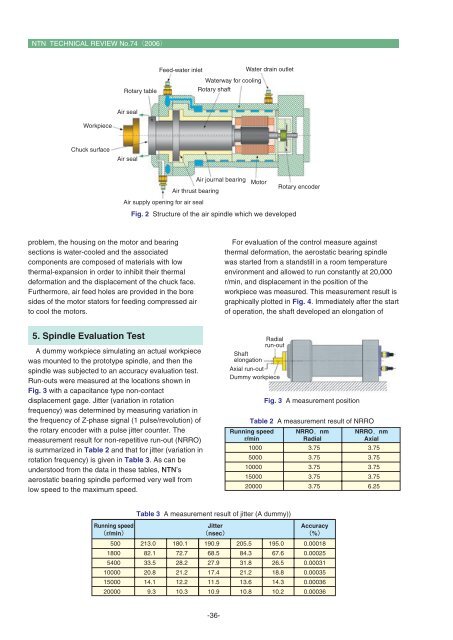
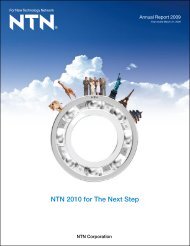
![[New Product] Unit Products for Office Equipment - NTN](https://img.yumpu.com/27154451/1/184x260/new-product-unit-products-for-office-equipment-ntn.jpg?quality=85)
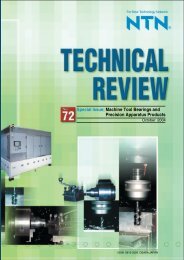
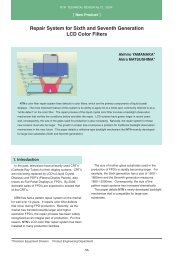
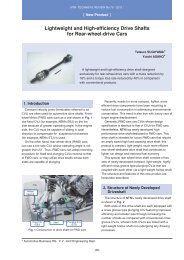
![[New Product] Development of Oil-impregnated Sintered ... - NTN](https://img.yumpu.com/27154427/1/184x260/new-product-development-of-oil-impregnated-sintered-ntn.jpg?quality=85)

